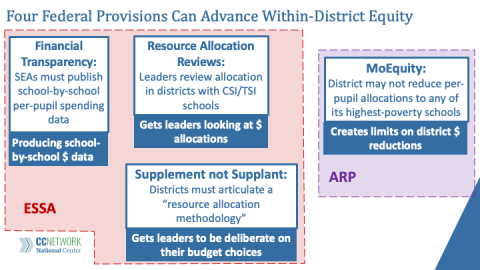Existing Federal Provisions Can—If Given Appropriate Attention—Advance Within-District Financial Equity


By Marguerite Roza and Hannah Jarmolowski
Educational equity has been this administration’s priority from the outset, and last week’s executive order reiterates that. So, it is noteworthy that there are four federal provisions already on the books that could—if implemented with fidelity—make a real impact on financial equity in schooling.
Financial equity can be measured both across districts and within districts by comparing fair distribution of dollars across schools. Here, we focus on within-district financial inequities that have frustrated federal lawmakers for decades.
The federal government tightly controls the 10% of school funds from federal coffers, but it’s been more challenging to address inequities stemming from the 90% from state and local sources. Each district decides how to allocate these funds across schools, and examples abound of districts that shortchange some schools at the expense of others with greater needs.
As shown below, there are four federal provisions (accumulated over three administrations) with potential to work together toward fostering equity. But thus far, none of these provisions has been fully implemented by every state, and one seems to have been ignored completely.

The financial transparency requirement—that SEAs report school-by-school expenditure data—is the furthest along, with every state now producing at least some data that can be used to spotlight inequities. But, with some states missing deadlines, or reporting inaccurate or incomplete figures, there’s still work to do. The next step is for leaders to examine these data, which would happen if more SEAs made good on the resource allocation review requirement. Thus far, it appears that only about half of all states are doing these reviews with their districts. Ideally, districts would then make the connection between inequities in the data and their budget strategies. And indeed, 2019 guidance on the supplement-not-supplant requirement calls on each district to articulate the “methodology” in place for resource allocation. None of the dozens of districts we’ve spoken to are even aware of the resource allocation methodology requirement, nor were leaders able to describe the approach used in their district.
To be fair, we haven’t seen proactive federal monitoring of any of these provisions to date (and admittedly, the last 20 months have been crazy-busy for state and district financial leaders).
That brings us to the most recent addition, which takes a much bolder step toward regulating district allocations. ARP’s maintenance of equity provision was originally intended to protect high-poverty schools from disproportionate cuts. But if implemented and followed as is now outlined in guidance, it would require districts to make pre-set allocations of state and local dollars (at a level established the prior year) to the quarter of schools with the most students in poverty. (This provision is still unfolding with new guidance updated earlier this month and a request for comment due November 4th.)
Each requirement works in different ways, but if made a priority, together they can drive awareness, engagement, and financial changes in school districts. For those hoping to advance equity across schools, an obvious place to start is with the federal levers already in place.
This blog was adapted from an October 21, 2021, presentation to the Comprehensive Center Network. Slides are available here.